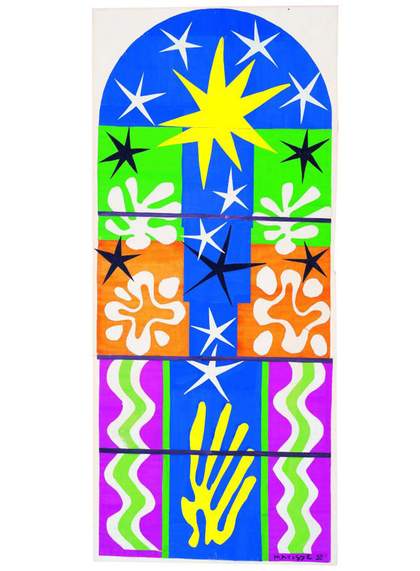
Henri Matisse (1869 -1964)
Nuit de Noel 1952
Gouache on paper, cut and pasted and mounted on board
MoMA
© 2013. The Museum of Modern Art, New York / Scala Florence
© Succession Henri Matisse/DACS 2013
My earliest memory of seeing a Matisse cut-out was Maquette for Nuit de Noël (1952), the large window design in the collection of the Museum of Modern Art in New York. I was merely a child and this piece thrilled me to the core of my being. It was a deeply personal and resonant experience, and it made me feel a part of a world. It would be no exaggeration to report that Henri Matisse has been the touchstone of my artistic existence ever since. For me, he is the seminal thinker and practitioner of the modern era.
From the standpoint of my own approach to things, what I have always most appreciated about his cut-outs is the absolute mobility of their freely formed elements. The sheets of drawing paper were pre-painted with gouache, then independently scissor-cut and brought to an evolving pictorial situation (a wall, or other sheets of white paper). This constituted a radical liberation from the more deliberately sequenced, chronological development of a painting. The pinning down, temporarily, of coloured paper shapes which can then be added to, exchanged, or removed from various grounds or previous iterations represented a very new and original approach to his visual research.
I think Matisse initially came to use cut paper as a diagnostic tool, to test the effect of larger swathes of colour in ambitious mural projects such as the Barnes Foundation lunettes. Eventually, of course, he saw the cut-outs as ends in themselves, a vast new frontier enabling him to turn his compositions into magnetic fields - as brilliant for their economy of means as they are for their vibrancy and energy of expression.
The sharpness of the cut paper, the edges of the colour planes and their juxtaposition provide the works with an enormous sense of scale - an infinitude almost. Even the smaller ones look as if they could occupy an entire wall and still maintain a feeling of intimacy. It is interesting to me how their razor-sharpness gives them such a fully dimensional reality: they become imaginally real.
Also, I see the cut-outs as being profoundly imbued with the memory of Matisse’s first visit to New York in 1930. Upon his arrival, he experienced what he described as the ‘crystalline’ quality of light: sharp, penetrating, unfiltered and quite distinct from what his acute photic sensibility had previously known. I believe the shock of this encounter stayed with him, and shows us just how crucial the role of sensual memory and geography was in the development of his work. In fact, the cut-outs do have a staccato-like clarity, a sharpness and prismatic exuberance which epitomised for him the New World.
The distinctive philosophical principle of them for Matisse, in his own words, was that ‘they are an assemblage of signs invented during the picture’s execution to suit the needs of their positions’. Although I have always loved this particular remark as a working mantra, I would add another factor which I find to be of compelling interest, especially with regard to how the cut-outs function for the viewer. This has to do with the dramatically contrasting velocities that belong to the execution of these works.
Matisse was in the habit of using his scissors with maniacal speed. He cut the paper with great precision, and he cut it as fast as he could. He got into a rhythm as fluid and as exacting as his figure drawing. When a sufficient number of pieces had been produced and assembled, he would then enter into another and very different phase. He started using the colour shapes almost as artefacts from a previous activity, as he began the painstaking and deliberative process of fine-tuning the composition. He would devote so much attention to this that he rarely had time actually to glue the paper elements to the surfaces. Their positions were indicated and the final composition sent away to be completed at another location. Many were simply pinned to a surface or quickly spot-glued until after the death of the artist.
What I am trying to suggest here, and I think it is something which can be easily overlooked, is that the different speeds inherent in the cut-outs, the rapid improvisatory scissor cuts, and their slow and carefully organised placement (which is still a further zone of improvisation), are what lends these works their singular magical power.
To say that Matisse was a radical experimentalist, that he invented methods of art-making which pose new challenges for future generations, seems like a foregone conclusion. Yet to call him an avant-garde artist is also somehow beside the point. He didn’t have to try to move ahead of other artists, because he was already there. His purpose was to consolidate and to distil his understanding of the history of art for the rest of us. He wanted to make his works more complete by including elements unknown to him, a process of synthesis that he was continuing to master towards the very end of his life.
Most importantly, Matisse had the courage to remain steadfast in his commitment to his central artistic vocation, which was to stir the emotional and sensual depths of the human soul. And there is nothing more avant-garde or forward-looking than this.
